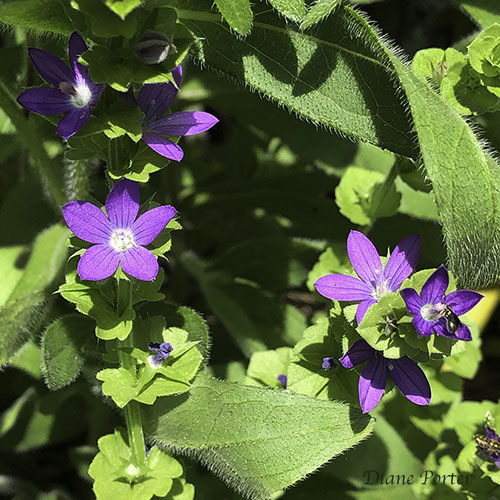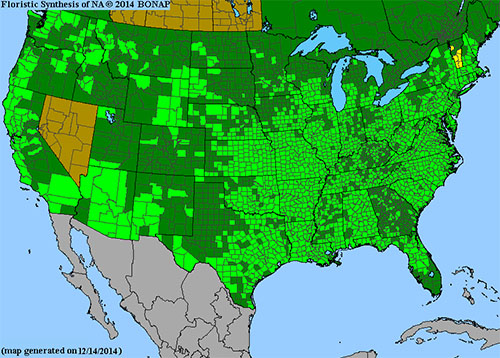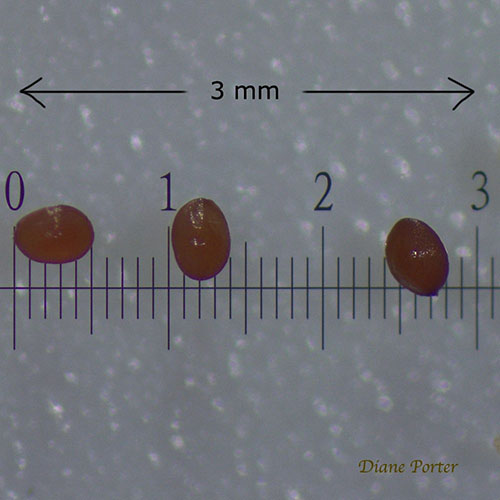Venus' Looking Glass
Named for beauty

This dainty flower has bloomed all over my little garden outside the living room.
I discovered it several years ago, buried in tall grass in a weedy field. I marked the spot with fluorescent tape and checked back every few days until I was able to gather a few seeds.
For saving those few seeds, Venus' Looking Glass has rewarded me many times over. Now it's a lacy ground cover for my flower garden in early spring, and a delight as summer comes on.
The plant is so tiny and spindly that it would be easy to weed it out in spring. It comes up all over the place and looks a bit like ground ivy or something else that you don't really want in your flower beds.
But it you let it grow, then it stands up rather taller than you would think possible. And sort of wispy and wavery. Really nothing to even notice, until the pretty purple blossoms open. Then suddenly I'm in love with it again.

Each flower comes out close to the stem, which seems to come up right through a whorl of leaves. The leaves form a sort of cup.
The seeds
When the seeds form, they fall into the leaf cup and linger there until something bounces them out. It is pretty good fun to tip over a stem and see the microscopic seeds flow whatever you've brought with you to catch them.

The seeds are tiny. As fine as dust. Each one is about half a millimeter wide. Without a magnifying glass, you can't see that they are seeds at all. According to Prairie Moon Nursery, 3 million seeds make one ounce. So I won't be filling up a mason jar with them.
I don't know to what purpose the plant catches its own seeds in its leaf cups. I can't think of any other plant that does that. But it charms me.
The names of Venus' Looking Glass
Full common name:
Venus' Looking Glass. The name refers to the shiny quality of the seeds, like a mirror, I suppose. However, it seems perhaps unwarranted. The seeds are almost invisibly tiny. Perhaps they could reflect the face of an ant. However, Venus, as the goddess of beauty seems quite appropriate. I think of this plant simply as Venus, and that is what I put on the labels I use to mark where I've planted them.
Scientific name:
Triodanis perfoliata
Family names:
Venus' Looking Glass is in the Bellflower family, the Campanulaceae.
Where Venus lives

Venus' Looking Glass is a native wildflower of North America. It grows wild is almost every state, with something of a predilection for the more southeastly parts of the continent.
The map shows the native range of Venus' Looking Glass. The light green color shows counties where it is found growing wild. This map was produced by The Biota of North America Program (BONAP).
It will be happy in your garden in a site in full sun. It doesn't need to be coddled with a lot of water, as it is adapted to life on the prairie. And it does better if the soil isn't particularly rich, so I never fertilize it. It can stand Spartan conditons, but it is too delicate to endure much competition from bigger, more robust plants.
Stratification — three months in the cold

If you obtain seeds of Venus' Looking Glass, you can scatter them in late fall, and they will sprout the next spring. If you want to start them indoors, you must provide three months of cold, damp conditions. This is called "cold stratification." I often start some seeds in a sandwich box of damp seed starting mix, putting it in the refrigerator around the first of the year. Then I take the box out and put it under lights by the first of April. This gives me an early start.
In 2022 I just put the whole sandwich box outside with the top open in late fall, where it would receive rain and snow. The only extra care was to keep it under a screen roof that excluded the darling chipmunks, who would otherwise dig up every pot. This spring the box was full of seedlings, and I transplanted them into the garden. They have done well. But since the ones that sowed themselves last year are also in fine fettle now, I think it's not necessary to start seeds indoors.
From now on I'll simply collect seeds (if I can catch them) and scatter them where I want Venus to bloom the next year.
— Diane Porter, Fairfield, Iowa, June 18, 2022
See more of Diane's blogposts about plants

